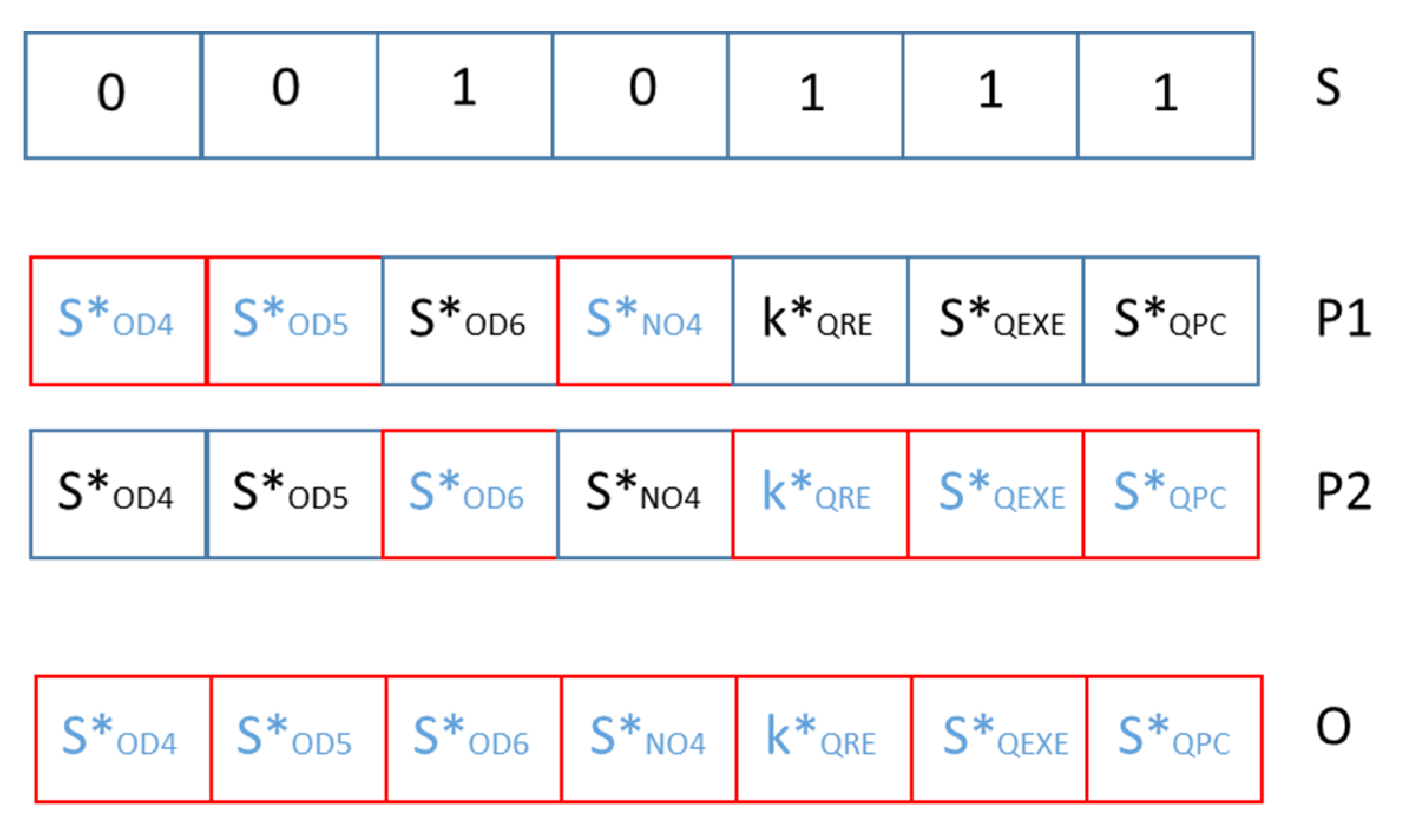Optimal-Setpoint-Based Control Strategy of a Wastewater Treatment Process
Abstract
1. Introduction
- modernization of wastewater collecting and treatment infrastructure in urban areas in parallel with the development of new wastewater treatment technologies;
2. Materials and Methods
2.1. Structure of the Wastewater Treatment Plant
2.2. Automation Equipment
- dissolved oxygen concentration loops in the tanks B4, B5 and B6;
- nitrate concentration control loop through internal recirculation. From the last tank—B7—the sludge is recirculated by a pumping group to the second tank, B2;
- the pump that ensures the sludge flow extracted from the primary clarifier ();
- the pump that ensures the sludge flow for the external recirculation ();
- the pump that determines the excess sludge flow from the secondary clarifier ().
2.3. The Influent Used in Simulations
2.4. Performance Criterion Regarding the Efficiency of the Wastewater Treatment Plant
- Effluent quality (EQI)—J1where T = t2 − t1 represents the total evaluation period, in our case 28 days, between days t1 = 84 and t2 = 112. The weighting coefficients , , , and are used to convert the effluent loads into pollution units. The values of these coefficients were taken from [16], having the following values: , , , , and .
- “Failure” index—J3
- where Ex—percentage exceeding of the legal limits over the last 28 days.
- In this paper an aggregated performance criterion was considered:where α1, α2, α3 are weighting coefficients. They have the following values: α1 = 0.5, α2 = 1 and α3 = 100. They were chosen taking into account the size orders of the indexes J1–J3 so as to ensure a balanced contribution in the global indicator J.
2.5. Control Strategy
- computation of the optimal setpoint set for operating regimes;
- obtaining the current optimal setpoint set for the current operating regime or, in the case of transitions between regimes, taking into account the membership to the operating regime through a fuzzification block.
2.5.1. Computation of the Optimal Setpoints for Operating Regimes
2.5.2. Computation of the Current Optimal Setpoint Set for the Current Operating Regime or in the Case of Transitions between Regimes
3. Results and Discussions
3.1. Computation of the Optimal Setpoints for Each of the Three Operating Regimes
3.2. Computation of the Current Optimal Setpoint Set for the Current Pluviometric Regime or in the Case of Transitions between Regimes
4. Conclusions
Author Contributions
Funding
Conflicts of Interest
Appendix A
- a chromosome consists of seven genes being exactly the searched setpoints, which are the components of the vector V*, given by (5) (see Figure A1);Figure A1. Chromosome structure.
- for the generation of the initial population, searching intervals of the optimal solution are chosen (see Table 3). Their choice was made upon technological considerations;
- an offspring chromosome (O) is obtained from two parent chromosomes (P1 and P2). For crossover a binary vector was used, having the same length as that of a chromosome whose values will be randomly chosen. Let us denote this vector by S. Once this vector is generated, each gene k of offspring chromosome will inherit the value of gene k of the first parent if S(k) = 0 or the value of gene k of the second parent if S(k) = 1, according to Figure A2;Figure A2. Crossover operation.
- selection of the parent chromosomes is made randomly, with a probability inversely proportional to the value of the offspring chromosome’s fitness function. Thus, chromosomes with the low fitness function are more likely to be selected as parents;
- the mutation operator adds to each parent gene a randomly chosen value from a Gaussian distribution with zero mean and standard deviation calculated for each gene according to the relation:where
- k—number of the current generation.
- Gen—total number of generations for which the algorithm is run.
- —standard deviation of the Gaussian distribution at generation k.
- —standard deviation at the first generation—has the value equal to the size of the gene range that undergoes mutation (for example, varies between 0.4 and 4, so for this gene ).
References
- Council of the European Communities (CEC). Directive concerning urban wastewater treatment (91/271/EEC). Off. J. Eur. Commun. 1991, 34, 40. [Google Scholar]
- DCE. “Directive 2000/60/CE du Parlement européen et du Conseil du 23 octobre 2000 établissant un cadre pour une politique communautaire dans le domaine de l’eau. J. Off. 2001, 327, 0001–0073. [Google Scholar]
- Jeppsson, U. Modelling Aspects of Wastewater Treatment Processes. Ph.D. Thesis, Lund Institute of Technology, Lund, Sweden, 1996. [Google Scholar]
- Yang, Y.Y.; Linkens, D.A. Modelling of Continuous Bioreactors via Neural Networks. Trans. Inst. Meas. Control 1993, 15, 158–169. [Google Scholar] [CrossRef]
- Barbu, M.; Caraman, S.; Ifrim, G.; Bahrim, G.; Ceanga, E. State observers for food industry wastewater treatment processes. J. Environ. Prot. Ecol. 2011, 12, 678–687. [Google Scholar]
- Katebi, M.R.; Johnson, M.A.; Wilke, J. Control and Instrumentation for Wastewater Treatment Plant; Springer: London, UK, 1999. [Google Scholar]
- Olsson, G.; Newell, B. Wastewater Treatment Systems—Modelling, Diagnosis and Control; IWA Publishing: London, UK, 1999. [Google Scholar]
- Dochain, D.; Vanrolleghem, P. Dynamical Modeling & Estimation in Wastewater Treatment Processes; IWA Publishing: London, UK, 2001. [Google Scholar]
- Henze, M.; Grady, C.P.L., Jr.; Gujer, W.; Marais, G.V.R.; Matsuo, T. Activated Sludge Model No. 1; IAWQ Scientific and Technical Report No. 1; IAWQ: London, UK, 1987. [Google Scholar]
- Henze, M.; Gujer, W.; Mino, T.; Matsuo, T.; Wentzel, M.C.; Marais, G.V.R. Activated Sludge Model No. 2; IAWQ Scientific and Technical Report No. 3; IAWQ: London, UK, 1995. [Google Scholar]
- Henze, M.; Gujer, W.; Mino, T.; van Loosdrecht, M. Activated Sludge Models AMS1, ASM2, ASM2d and ASM3, IWA STR No. 9; IWA Publishing: London, UK, 2000. [Google Scholar]
- Batstone, D.; Keller, J.; Angelidaki, I.; Kalyuzhnyi, S.; Pavlostathis, S.; Rozzi, A.; Sanders, W.; Siegrist, H.; Vavilin, V. The IWA Anaerobic Digestion Model No 1 (ADM1). Water Sci. Technol. 2002, 45, 65–73. [Google Scholar] [CrossRef] [PubMed]
- Batstone, D.J.; Keller, J. Industrial applications of the IWA anaerobic digestion model No.1 (ADM1). Water Sci. Technol. 2003, 47, 199–206. [Google Scholar] [CrossRef]
- Nejjari, F.; Dahhou, B.; Benhammou, A.; Roux, G. Non-linear multivariable adaptive control of an activated sludge wastewater treatment process. Int. J. Adapt. Control Signal Process. 1999, 13, 347–365. [Google Scholar] [CrossRef]
- Boger, Z. Application of neural networks to water and wastewater treatment plant operation. ISA Trans. 1992, 31, 25–33. [Google Scholar] [CrossRef]
- Jeppsson, U.; Pons, M.-N.; Nopens, I.; Alex, J.; Copp, J.B.; Gernaey, K.V.; Rosen, C.; Steyer, J.-P.; Vanrolleghem, P.A. Benchmark Simulation Model No 2 – General protocol and exploratory case studies. Water Sci. Technol. 2007, 56, 67–78. [Google Scholar] [CrossRef]
- Alex, J.; Benedetti, L.; Copp, J.B.; Gernaey, K.V.; Jeppsson, U.; Nopens, I.; Pons, M.-N.; Rosen, C.; Steyer, J.-P.; Vanrolleghem, P. Benchmark Simulation Model No 1, Prepared by the IWA Taskgroup on Benchmarking of Control Stategies for WWTPs; Department of Industrial Electrical Engineering and Automation, Lund University: Lund, Sweden, 2008. [Google Scholar]
- Vrecko, D.; Gernaey, K.V.; Rosen, C.; Jeppsson, U. Benchmark simulation model No 2 in Matlab-Simulink: Towards plant-wide WWTP control strategy evaluation. In Proceedings of the IWA World Water Congress, Beijing, China, 10–14 September 2006. [Google Scholar]
- Chirosca, A.; Luca, L.; Ifrim, G.; Caraman, S. Robust control of the biological wastewater treatment process. In Proceedings of the 2013 17th International Conference on System Theory, Control and Computing, ICSTCC 2013, Joint Conference of SINTES 2013, SACCS 2013, SIMSIS 2013, Sinaia, Romania, 11–13 October 2013. [Google Scholar]
- Brdys, M.A.; Zhang, Y. Robust Hierarchical Optimizing Control of Municipal Wastewater Treatment Plants. In Proceedings of the 9th IFAC/IFORS/IMACS/IFIP Symposium Large Scale Systems: Theory & Applications, Bucharest, Romania, 18–20 July 2001; pp. 540–547. [Google Scholar]
- Georgieva, P.G.; de Azevedo, S.F. Robust control design of an activated sludge process. Int. J. Robust Nonlinear Control 1999, 9, 949–967. [Google Scholar] [CrossRef]
- Luca, L.; Barbu, M.; Ifrim, G.; Ceangă, E.; Caraman, S. Control Strategies of a Wastewater Treatment Plant. In Proceedings of the 12th IFAC Symposium on Dynamics and Control of Process Systems, Including Biosystems, Florianopolis, Brazil, 23–26 April 2019. [Google Scholar]
- Caraman, S.; Sbarciog, M.; Barbu, M. Predictive control of a wastewater treatment process. IFAC Proc. Vol. 2006, 39, 155–160. [Google Scholar]
- Mulas, M.; Tronci, S.; Corona, F.; Haimi, H.; Lindell, P.; Heinonen, M.; Vahala, R.; Baratti, R. Predictive control of an activated sludge process: An application to the Viikinmäki wastewater treatment plant. J. Process Control 2015, 35, 89–100. [Google Scholar]
- Bastin, G.; Dochain, D. On-Line Estimation and Adaptive Control of Bioreactors; Elsevier: Amsterdam, The Netherlands, 1990. [Google Scholar]
- Guerrero, J.; Guisasola, A.; Vilanova, R.; Baeza, J.A. Improving the performance of a WWTP control system by model-based setpoint optimization. Environ. Model. Softw. 2011, 26, 492–497. [Google Scholar]
- Luca, L.; Ifrim, G.; Ceanga, E.; Caraman, S.; Barbu, M.; Santin, I.; Vilanova, R. Optimization of the Wastewater Treatment Processes Based on the Relaxation Method; ISEEE: Galati, Romania, 2017. [Google Scholar]
- Xu, H.; Vilanova, R. PI and fuzzy control for P-removal in wastewater treatment plant. Int. J. Comput. Commun. Control 2015, 10, 176. [Google Scholar]
- Santín, I.; Pedret, C.; Vilanova, R.; Meneses, M. Advanced decision control system for effluent violations removal in wastewater treatment plants. Control Eng. Pract. 2016, 49, 60–75. [Google Scholar]
- Manesis, S.A.; Sapidis, D.J.; King, R.E. Intelligent Control of Wastewater Treatment Plants. Artif. Intell. Eng. 1998, 12, 275–281. [Google Scholar]
- Laurentiu, L. Advanced Control Strategies for Biological Waste Water Treatment Processes. Ph.D. Thesis, Galati University Press, Galati, Romania, 2018. [Google Scholar]
- Piotrowski, R.; Skiba, A. Nonlinear Fuzzy Control System for Dissolved Oxygen with Aeration System in Sequencing Batch Reactor. Inf. Technol. Control 2015, 44, 182–195. [Google Scholar]
- Piotrowski, R.; Błaszkiewicz, K.; Duzinkiewicz, K. Analysis the Parameters of the Adaptive Controller for Quality Control of Dissolved Oxygen Concentration. Inf. Technol. Control 2016, 45, 42–51. [Google Scholar]
- Piotrowski, R.; Lewandowski, M.; Paul, A. Mixed integer nonlinear optimization of biological processes in wastewater sequencing batch reactor. J. Process Control 2019, 84, 89–100. [Google Scholar]
- Piotrowski, R.; Paul, A.; Lewandowski, M. Improving SBR performance alongside with cost reduction through optimization of biological processes and dissolved oxygen concentration trajectory. Appl. Sci. 2019, 9, 2268. [Google Scholar]
- Hirsch, P.; Piotrowski, R.; Duzinkiewicz, K.; Grochowski, M. Supervisory Control System for Adaptive Phase and Work Cycle Management of Sequencing Wastewater Treatment Plant. Stud. Inform. Control 2016, 25, 153–162. [Google Scholar] [CrossRef]
- Piotrowski, R.; Brdys, M.A.; Konarczak, K.; Duzinkiewicz, K.; Chotkowski, W. Hierarchical dissolved oxygen control for activated sludge processes. Control Eng. Pract. 2008, 16, 114–131. [Google Scholar] [CrossRef]
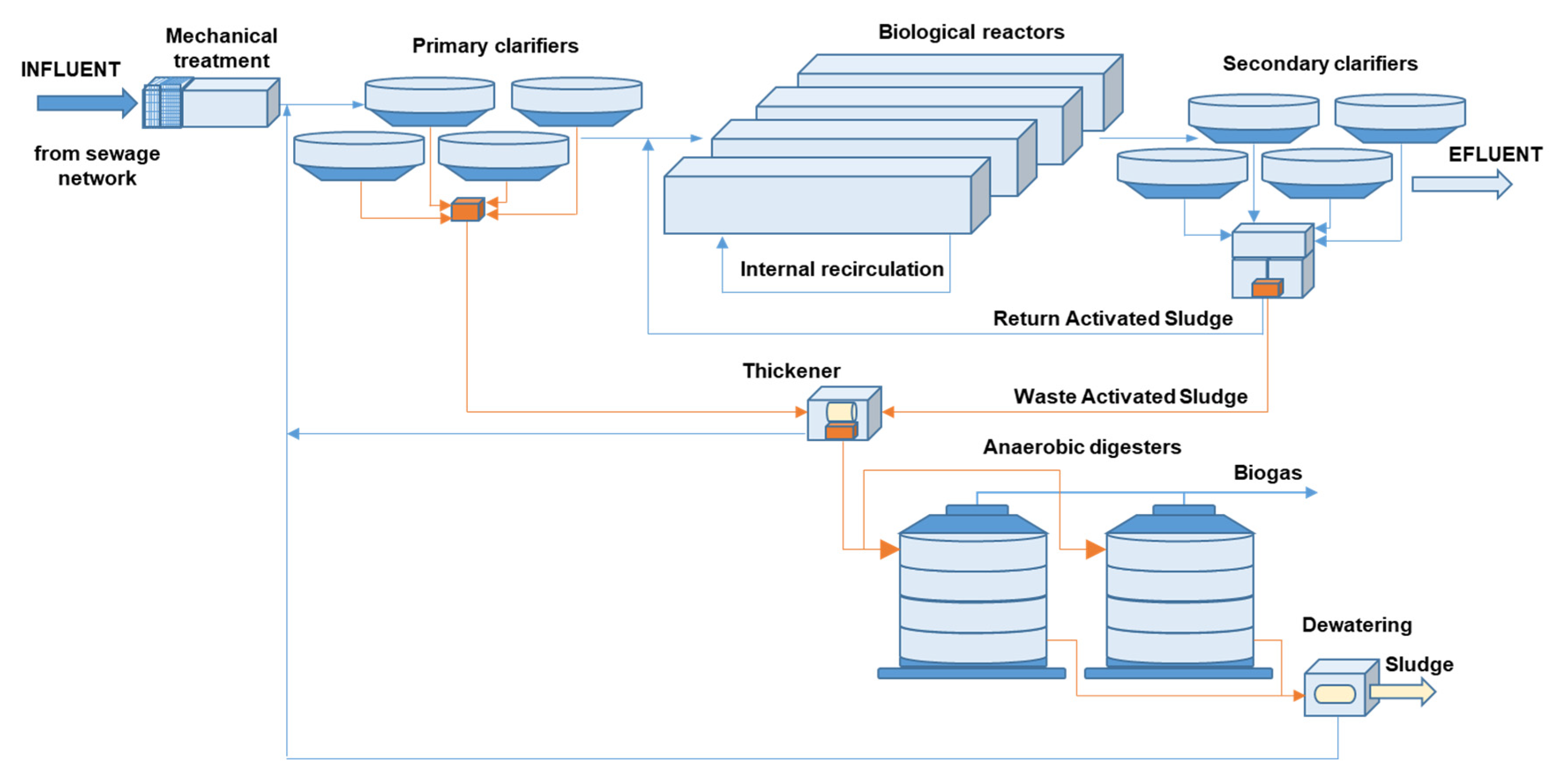

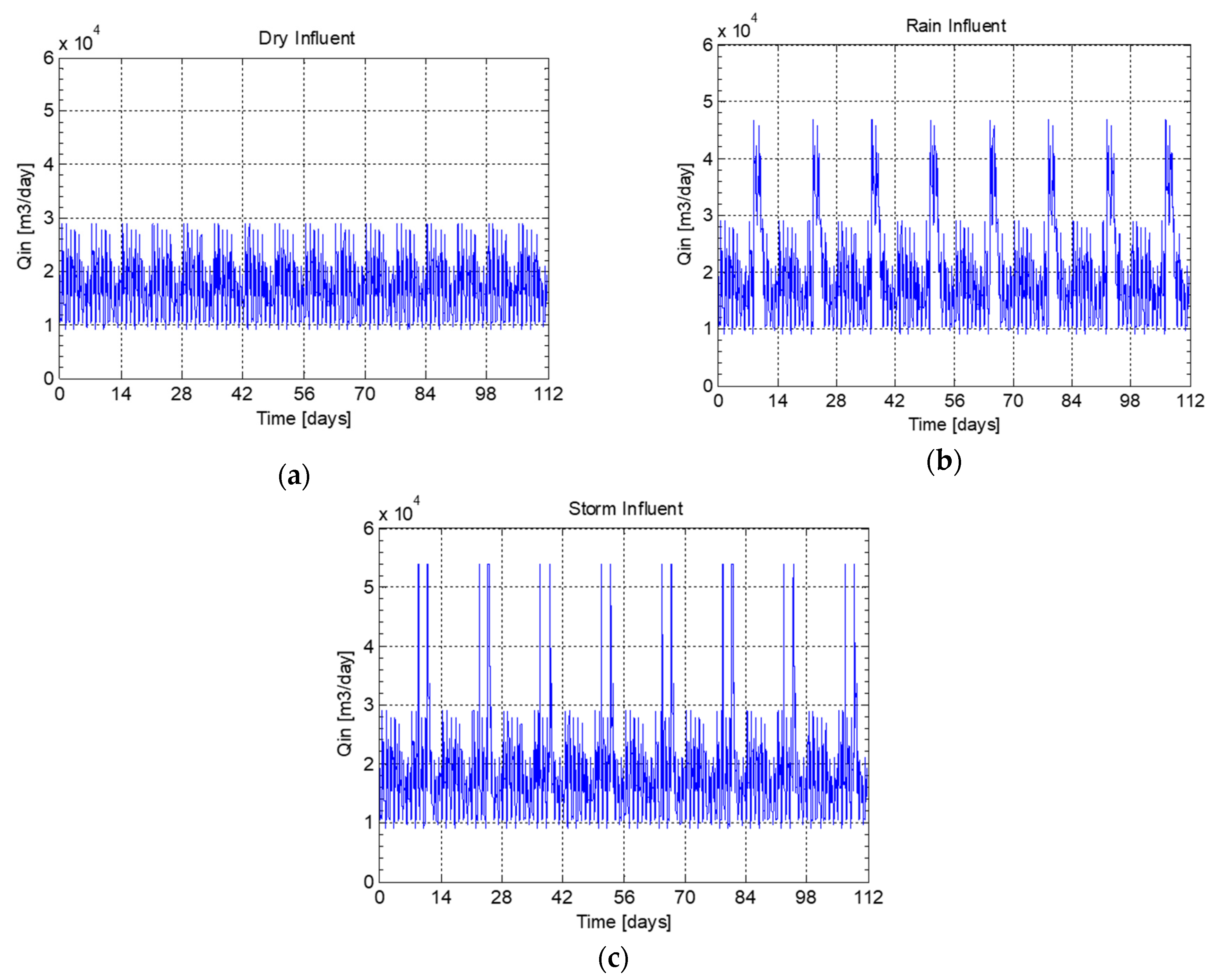
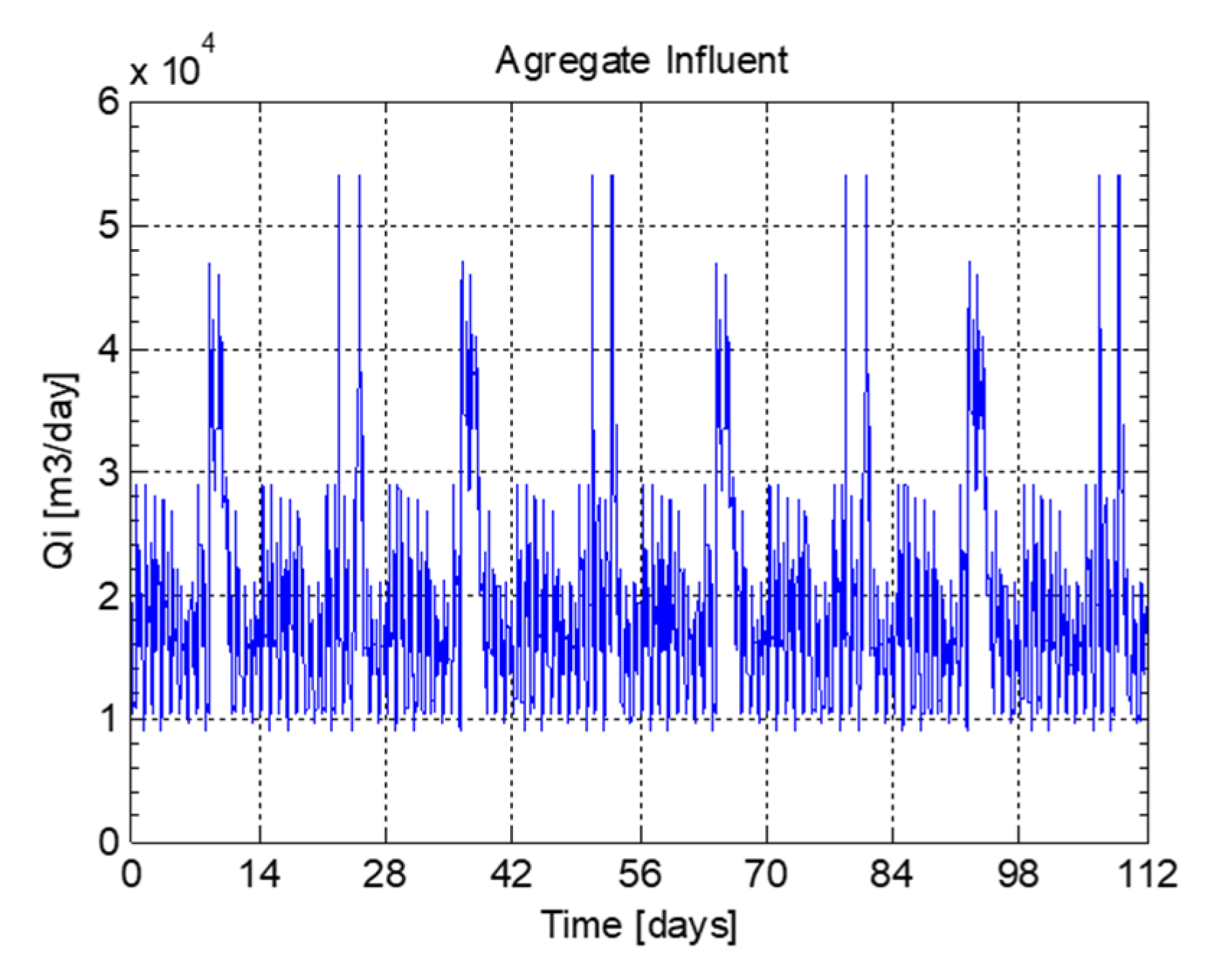
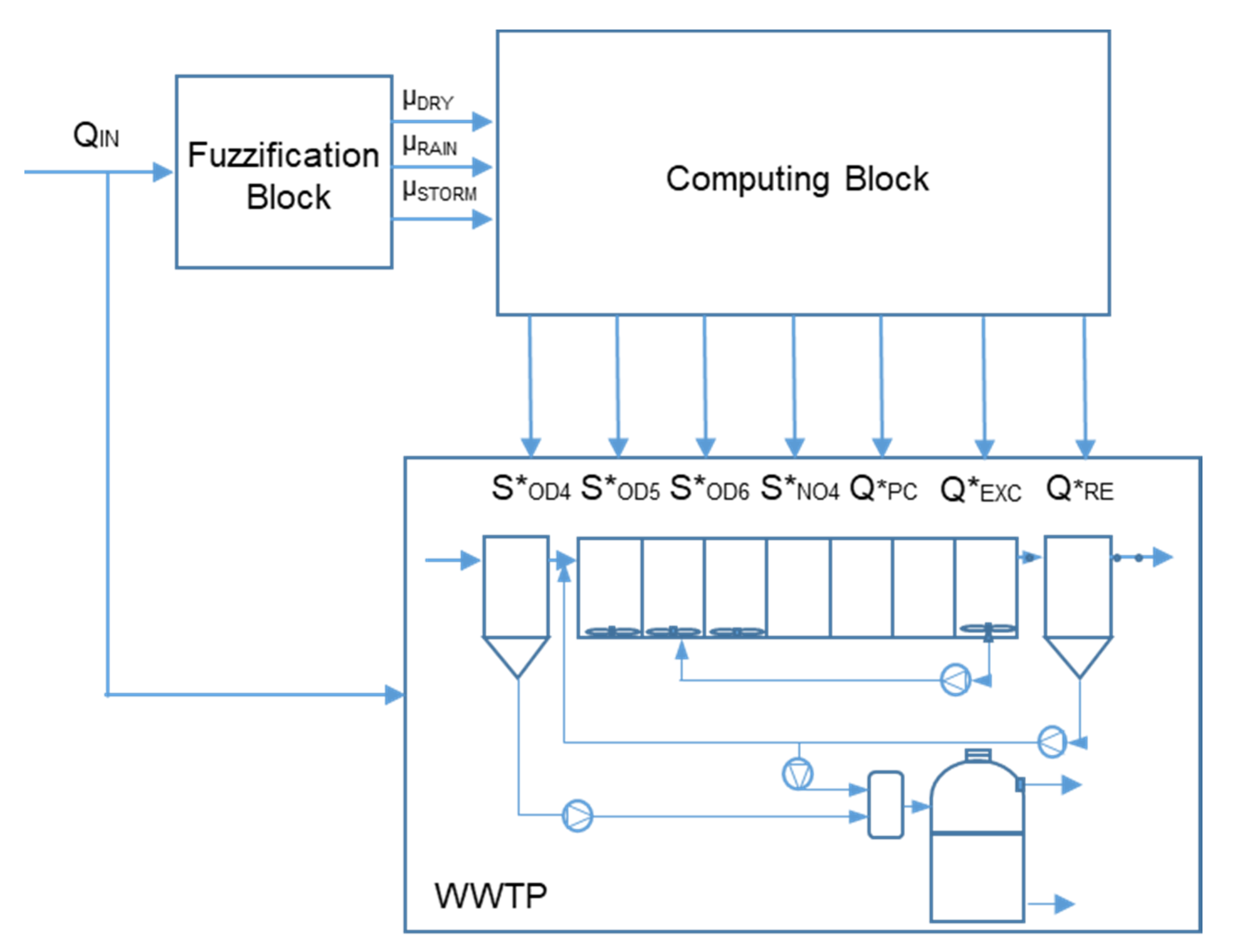
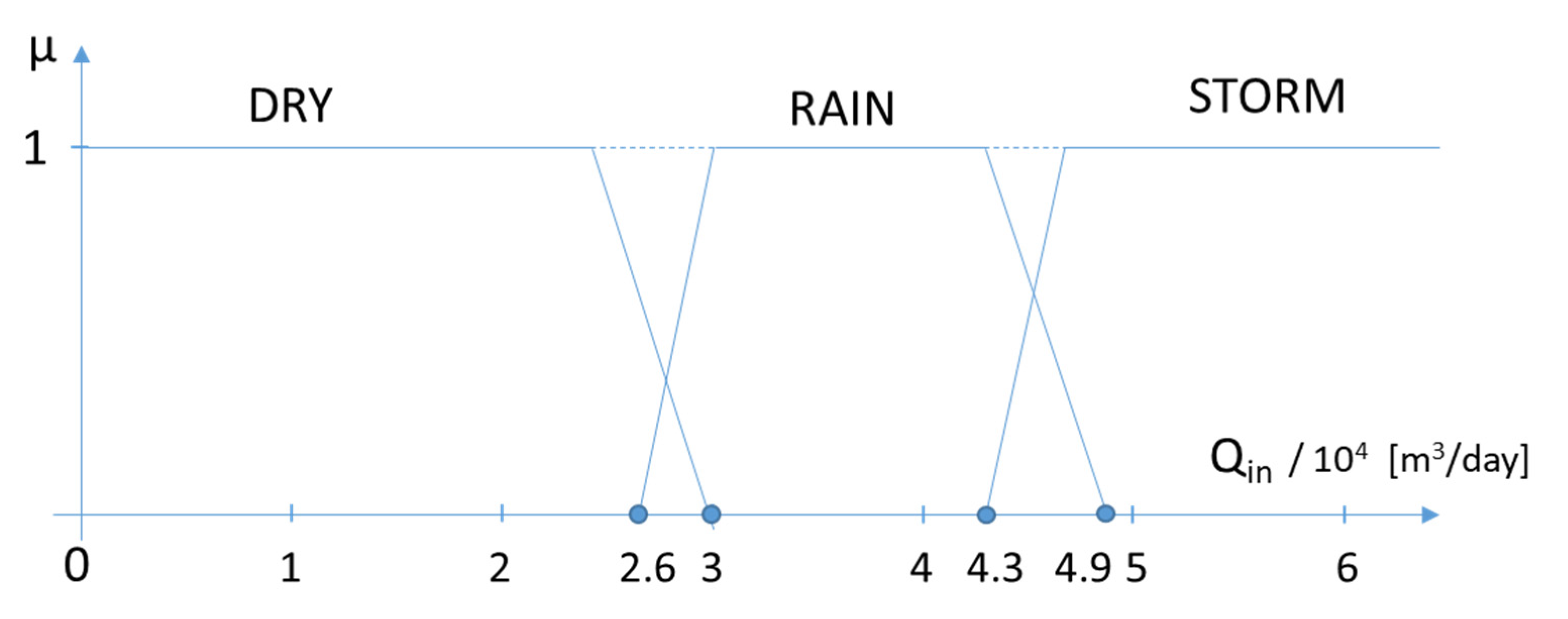
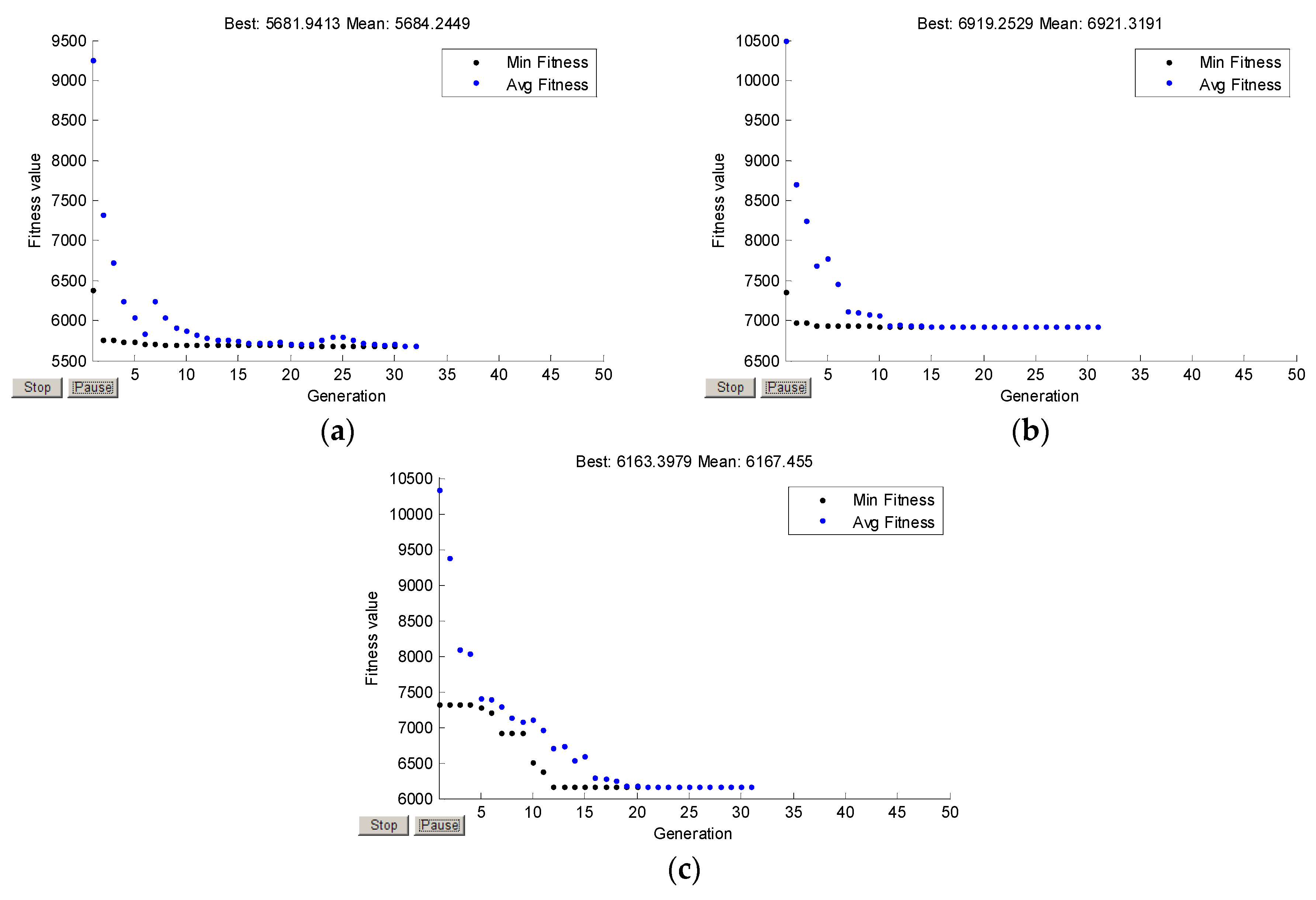
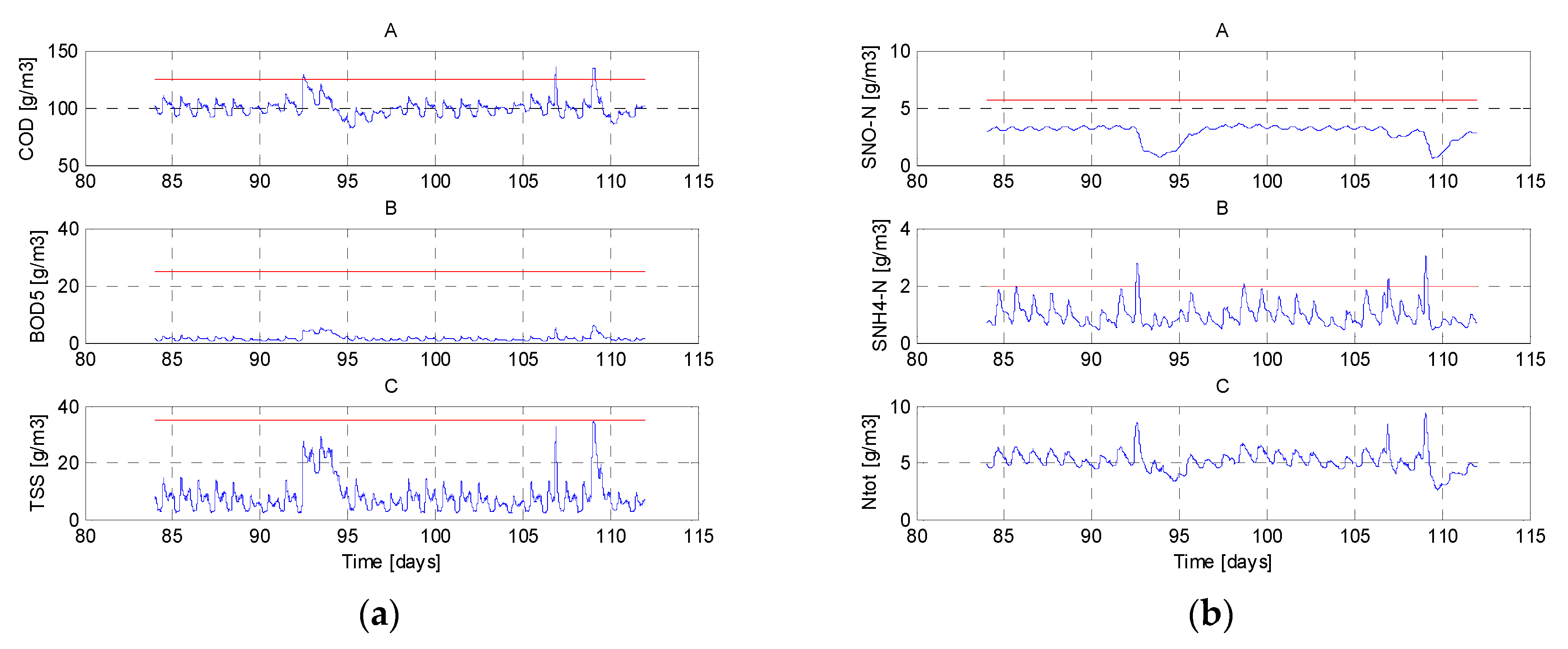
| Type of the Tank | Capacity (m3) |
|---|---|
| Primary clarifier (PC) | 3300 |
| Anoxic tank (B1) | 1200 |
| Anoxic tank (B2) | 2200 |
| Aerated tank (B3 and B4) | 2200 |
| Aerated tank (B5 and B6) | 3300 |
| Deaeration tank (B7) | 500 |
| Secondary clarifier (SC) | 9200 |
| Anaerobic digester (AD) | 6300 |
| WWTP Design Values | Measured Average Values | ||||||
|---|---|---|---|---|---|---|---|
| No. | Parameters | DRY | RAIN | STORM | DRY | RAIN | STORM |
| 1 | NH4 [g/m3] | 36.77 | 34.09 | 35.2 | 31.65 | 29.34 | 30.8 |
| 2 | Ntot [g/m3] | 60.65 | 56.17 | 58.74 | 40.39 | 37.43 | 39.42 |
| 3 | TSS [g/m3] | 401.61 | 370.93 | 395.63 | 132 | 121.91 | 130.07 |
| 4 | BOD5 [g/m3] | 342.96 | 316.91 | 336.89 | 133.66 | 123.6 | 131.1 |
| 5 | COD [g/m3] | 637.89 | 593.92 | 628.87 | 236.93 | 219.95 | 233.12 |
| MIN | MAX | [units] | |
|---|---|---|---|
| 0.3 | 4 | [mg/L] | |
| 0.4 | 4 | [mg/L] | |
| 0.4 | 4 | [mg/L] | |
| 1 | 8 | [mg/L] | |
| 0.5 | 4 | (dimensionless) | |
| 200 | 720 | [m3/day] | |
| 60 | 240 | [m3/day] |
| Regime | |||||||
|---|---|---|---|---|---|---|---|
| DRY | 0.38 | 3.07 | 1.37 | 4.28 | 1.84 | 488.10 | 98.97 |
| RAIN | 0.67 | 1.25 | 1.95 | 1.52 | 1.71 | 349.52 | 100.05 |
| STORM | 0.48 | 1.51 | 2.34 | 6.28 | 1.68 | 470.10 | 99.78 |
| DRY | RAIN | STORM | |
|---|---|---|---|
| IQI | 68,872.00 | 68,697.00 | 70,510.00 |
| J1(EQI) | 5591.00 | 6958.00 | 5989.00 |
| J2(OCI) | 2886.44 | 3047.33 | 2809.18 |
| Ex_Ntot [%] | 0.00 | 0.00 | 0.00 |
| Ex_NH4 [%] | 0.00 | 1.52 | 1.85 |
| Ex_NO4 [%] | 0.00 | 0.00 | 0.00 |
| Ex_TSS [%] | 0.00 | 0.20 | 0.00 |
| Ex_COD [%] | 0.00 | 2.21 | 1.74 |
| Ex_BOD [%] | 0.00 | 0.00 | 0.00 |
| J3 (failure) | 0.00 | 392.92 | 359.72 |
| J (aggregate) | 5681.94 | 6919.25 | 6163.4 |
| AGGREGATE | |
|---|---|
| IQI | 69,653 |
| J1(EQI) | 6151 |
| J2(OCI) | 3176.60 |
| Ex_Ntot [%] | 0.00 |
| Ex_NH4 [%] | 1.75 |
| Ex_NO4 [%] | 0.00 |
| Ex_TSS [%] | 0.00 |
| Ex_COD [%] | 1.29 |
| Ex_BOD [%] | 0.00 |
| J3 (failure) | 303.14 |
| J (aggregate) | 6555.24 |
© 2020 by the authors. Licensee MDPI, Basel, Switzerland. This article is an open access article distributed under the terms and conditions of the Creative Commons Attribution (CC BY) license (http://creativecommons.org/licenses/by/4.0/).
Share and Cite
Caraman, S.; Luca, L.; Vasiliev, I.; Barbu, M. Optimal-Setpoint-Based Control Strategy of a Wastewater Treatment Process. Processes 2020, 8, 1203. https://doi.org/10.3390/pr8101203
Caraman S, Luca L, Vasiliev I, Barbu M. Optimal-Setpoint-Based Control Strategy of a Wastewater Treatment Process. Processes. 2020; 8(10):1203. https://doi.org/10.3390/pr8101203
Chicago/Turabian StyleCaraman, Sergiu, Laurentiu Luca, Iulian Vasiliev, and Marian Barbu. 2020. "Optimal-Setpoint-Based Control Strategy of a Wastewater Treatment Process" Processes 8, no. 10: 1203. https://doi.org/10.3390/pr8101203
APA StyleCaraman, S., Luca, L., Vasiliev, I., & Barbu, M. (2020). Optimal-Setpoint-Based Control Strategy of a Wastewater Treatment Process. Processes, 8(10), 1203. https://doi.org/10.3390/pr8101203






